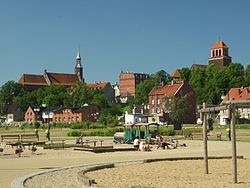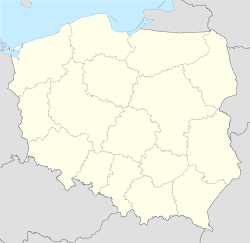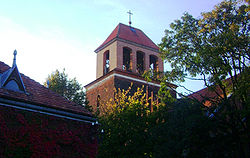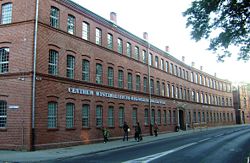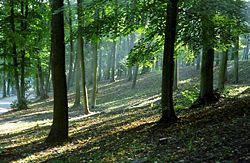- Tczew
-
Tczew Tczew Old Town seen from Vistula riverbank 
Flag
Coat of armsCoordinates: 54°6′N 18°43′E / 54.1°N 18.717°E Country  Poland
PolandVoivodeship Pomeranian County Tczew County Gmina Tczew (urban municipality) Established 12th century Town rights 1260 Government – Mayor Mirosław Pobłocki Area – Total 22.26 km2 (8.6 sq mi) Elevation 25 m (82 ft) Population (2009) – Total 60,279 – Density 2,708/km2 (7,013.6/sq mi) Time zone CET (UTC+1) – Summer (DST) CEST (UTC+2) Postal code 83-110 Area code(s) +48 58 Car plates GTC Website http://www.tczew.pl Tczew [tt͡ʂɛf] (Kashubian: Dërszewò; German:
 Dirschau (help·info)) is a town on the Vistula River in Eastern Pomerania, Kociewie, northern Poland with 60,279 inhabitants (June 2009). It is an important railway junction with a classification yard dating to the Prussian Eastern Railway (German: Preußische Ostbahn). The city is known for its attractive old town and the Vistula Bridge, or Bridge of Tczew, damaged during World War II.
Dirschau (help·info)) is a town on the Vistula River in Eastern Pomerania, Kociewie, northern Poland with 60,279 inhabitants (June 2009). It is an important railway junction with a classification yard dating to the Prussian Eastern Railway (German: Preußische Ostbahn). The city is known for its attractive old town and the Vistula Bridge, or Bridge of Tczew, damaged during World War II.It is the capital of Tczew County in Pomeranian Voivodeship since 1999, and was previously a town in Gdańsk Voivodeship (1975–1998).
Contents
History
Tczew was first mentioned as Trsow in a document by Duke Grzymisław bestowing the land to the Knights Hospitaller in 1198. In some documents, the name Derszewo appears, which stems from the name of a feudal lord, Dersław. It is unknown whether Trsow and Derszewo referred to the same or two neighboring settlements. By 1252 the settlement was known by the names Tczew and Dirschau, and in 1258 Tczew hosted the first city council in Poland. It received Lübeck rights from Duke Sambor II in 1260. Tczew was purchased by Heinrich von Plötzke of the Teutonic Knights following the Treaty of Soldin in 1309. It was rebuilt from 1364–1384 and granted Kulm law. After the Second Peace of Thorn (1466), Tczew was transferred from the Teutonic Order to the newly-created Polish province of Royal Prussia.
During the Protestant Reformation most of Tczew's inhabitants converted to Lutheranism. In 1577 the town was burnt to the ground by troops of King Stefan Batory of Poland after they defeated a rebellion by Gdańsk. A 1630 map by Willem Blaeu of the German Empire shows the city name Dirschau, as well as Kirchenbuecher [1] starting in 1637 of the mostly Protestant city. Although Tczew was rebuilt, it then suffered during the Polish-Swedish Wars.
The town was annexed from the Polish-Lithuanian Commonwealth by the Kingdom of Prussia during the Partitions of Poland. It was occupied by Polish troops of General Jan Henryk Dąbrowski in 1807 during the Napoleonic Wars, but became Prussian again in 1815. It became part of the German Empire in 1871.
Tczew grew rapidly during the 19th century after the opening of the Prussian Eastern Railway line connecting Berlin and Königsberg, with the Vistula bridge near Dirschau being an important part.
Under the Prussian and German rule, the Polish population suffered from heavy Germanization by foreign rulers of their territory;Polish farmers demanded Polish schools, and refused to teach their children German, German official Heinrich Mettenmeyer wrote that German appointed teachers were treated with highest disdain by Polish children and their parents[2]
The Prussian census of 1905 counted 15,144 Polish or Kashubian-speaking citizens and 25,466 German-speaking citizens in the town.
After World War I Treaty of Versailles, Tczew became part of the Second Polish Republic when troops of General Józef Haller entered the town on January 30, 1920. The town became a center of cultural activities of the German minority in Poland, a German-language school and a theater was founded. The regional member of the Polish Parliament represented the German minority. In December 1927 the Polish Ministry of Interior organized a conference of local and regional officials to discuss ways to de-Germanize the region and to obstruct the re-election of the German delegate. The conference noticed that the local Kashubians largely supported the German politicians. Also the German language was often used by local population. The conference decided to reinforce Polish national consciousness in the region. Officials were instructed to remove their children from the German-language school, in ethnically mixed cases the official should be sent to purely Polish regions if they refuse to follow these orders; additional measures included entertainment trips to various regions of Poland to encourage association with Polish culture and invoke pride at their heritage[3] In 1931 31 children were compelled to leave the German school and sent to a Polish-language school because they were Catholics or had a “Polish-sounding” name.[4]
During the Interwar period, Tczew was famous for its maritime academy which later moved to Gdynia.
According to the city's website, Tczew was the location of the start of World War II when German bombers attacked Polish sapper installations to prevent the bridge from been blown up at 04:34 on 1 September 1939 (the shelling of Westerplatte commenced at 04:45). The town was occupied by Nazi Germany during the war and liberated in 1945. After World War II Tczew was one of the most damaged cities of Gdańsk Pomerania. Virtually none of its remaining factories were capable of production. There had been considerable loss of population down to around 18-20 thousand people. Residents took the first effort of reconstruction, and revitalization. Currently, there are several companies in the electrical industry and machine building.
Coat of arms
The coat of arms of Tczew depicts a red griffin in honor of Duke Sambor II, who granted the town municipal rights in 1260.
Sights
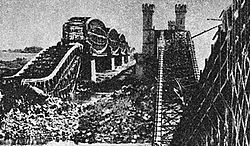 The Vistula bridge demolished by sappers of the Polish Army in September 1939 after the Wehrmacht invasion
The Vistula bridge demolished by sappers of the Polish Army in September 1939 after the Wehrmacht invasion
- Parish Church of the Holy Cross – situated in the centre of the Old Town, by Wyszyńskiego street. It is the oldest building in Tczew. The church was built in the 13th century and features a Baroque interior. The high brick tower is the oldest part of the church and its wooden top was destroyed during the fire in 1982. The interior church walls feature old frescoes, the oldest of which dates back to the latter half of the 15th century.
- Post-Dominican Church of Saint Stanislaus Kostka – located on Świętego Grzegorza square. It comes from the 14th century and is built in the Gothic style, with a characteristic octagonal tower. After the liquidation of the order, it was rebuilt into a school and later, till 1945, used by Protestants.
- Bridges on the Vistula River – located by Jana z Kolna street and the Vistula boulevard are Tczew's main sights. The road bridge was the first one to be constructed, between 1851 and 1857. At the time, with its 837 metres’ length, it was one of the longest bridges in the world. Originally, the bridge had ten towers and two gateways – today only four towers remain. The other, railway bridge, was built between 1888 and 1890, when one bridge was no longer sufficient. On September 1, 1939 at 5:30AM, the bridges were destroyed by Polish sappers in order to prevent the German Army from accessing the city from the other side of the Vistula River. The bridges were rebuilt in 1940 and destroyed again in 1945 by the Germans. The final reconstruction of the bridges took place between 1958 and 1959.
- Museum of the Vistula River – situated by 30 Stycznia street, in the pre-war agricultural machine factory where during World War II, the Nazi transitional camp for the people of Tczew was located. Then, the gas-meter factory operated in the building and after this the first museum of the Vistula River was established. In 2007, the building was renovated and now operates as the Museum of the Vistula River and Regional Centre of the Lower Vistula.
- Water Tower – located on the corner of 30 Stycznia and Bałdowska streets. It was built in 1905. The water tower presents former architectural style of municipal facilities. The 40-metre-high tower with the power of natural pressure distributed the water to the houses.
- City Hall – the old city hall was situated in Hallera square, in the centre of the Old Town. It was destroyed during the fire in 1916 and has never been rebuilt since. Now only the outline of the former city hall can be seen in the square. The new city hall was built in the Piłsudskiego square in the early 20th century.
- Dutch-type windmill – situated by Wojska Polskiego street. It was built in 1806. The windmill is wooden with brick foundations and has rarely seen five sails and a rotary head.
- Post Office – situated on the corner of Dąbrowskiego and Obrońców Westerplatte streets. It is the oldest post office in Tczew, built in 1905. On the front wall we can see the crests of Gdańsk and Tczew and also the Polish state emblem.
- The building of former Naval School – located by Szkoły Morskiej street. Built in 1911. At the beginning the girls’ school was situated there and later, between 1920 and 1930, it was the location of the first Naval School in Poland which was later moved to Gdynia. Nowadays, the building houses a secondary school.
- The building of former municipal baths – situated on Łazienna street. Built in 1913. Now the powiat council is based in this building.
- Municipal Park – located in the centre of Tczew, between Kołłątaja, Bałdowska, and Sienkiewicza streets occupies the area of 37 acres (15 ha). The lower part of the park arose in the second part of the 19th century, the upper part in the 20th century. In the park you can see an amphitheatre where, during the summer, many concerts take place. By the entrance to the park a monument of Tczew’s scouts killed during the World War II is situated.
Famous residents
- Grzegorz Ciechowski (1957–2001), singer, composer, record producer
- Alfred Eisenstaedt (1898–1995), photographer
- Johann Reinhold Forster (1729–1798), naturalist
- Bernhard Kamnitzer (1890–1959), politician
- Grzegorz Kołodko (1949–present), professor of economics, former deputy Prime Minister and Minister of Finance
- Jarosław Kukowski (1972–present), painter
- Marcin Mięciel (1975–present), footballer
- Zbigniew Robert Promiński (1978–present), black/death metal drummer
- Piotr Trochowski (1984–present), footballer
- Michał Zblewski (1980–present) Polish bobsledder
Population
1875: 9,713 inhabitants
1880: 10,939 inhabitants
1890: 11,897 inhabitants[5]
1960: 33,700 inhabitants
1970: 41,100 inhabitants
1975: 47,000 inhabitants
1980: 53,600 inhabitants
1990: 59,500 inhabitants
1995: 60,600 inhabitants
2000: 61,200 inhabitants
2005: 60,128 inhabitantsInternational relations
Twin towns — Sister cities
Tczew is twinned with:
 London Borough of Barking and Dagenham, United Kingdom (since 1999)
London Borough of Barking and Dagenham, United Kingdom (since 1999) Dębno, Poland (since 2000)
Dębno, Poland (since 2000) Beauvais, France (since 2005)
Beauvais, France (since 2005) Illichivsk, Ukraine (since 2006)
Illichivsk, Ukraine (since 2006) Aizkraukle, Latvia (since 2007)
Aizkraukle, Latvia (since 2007)
External links
- Municipal webpage (Polish)
- Cultural news and political information from Tczew (Polish)
- News and information from Tczew (Polish)
- Cultural news (Polish)
- Radio Fabryka - local radio (Polish)
- Birth, marriage and death records, 1637-1944
Coordinates: 54°06′N 18°43′E / 54.1°N 18.717°E
References
- Notes
- ^ churchbooks
- ^ Historia Pomorza , Tom 3,Część 2, Gerard Labuda Wydawnictwo Poznańskiego Towarzystwa Przyjaciół Nauk, 1996, page 144
- ^ Kotowski, Albert S. (1998) (in German). Polens Politik gegenüber seiner deutschen Minderheit 1919-1939. Forschungsstelle Ostmitteleuropa, University of Dortmund. p. 146. ISBN 3-447-03997-3. http://books.google.de/books?id=KVg_tMs_ZPIC&pg=PA365&dq=Goetheschule+Graudenz&hl=de&ei=j-AlTdz_JsvDswaVy9DMAg&sa=X&oi=book_result&ct=result&resnum=6&ved=0CDoQ6AEwBTgo#v=snippet&q=dirschau&f=false.
- ^ Eser, Ingo (2010) (in German). Volk, Staat, Gott, Die deutsche Minderheit in Polen und ihr Schulwesen 1918-1939. Nordost Institut, University of Hamburg. p. 414. ISBN 978-3-447-06233-6. http://books.google.de/books?id=SE4yRIlcs48C&pg=PA532&dq=graudenz&hl=de&ei=dPUaTezbId6K4gbxvrmGAg&sa=X&oi=book_result&ct=result&resnum=1&ved=0CCYQ6AEwADha#v=onepage&q=dirschau&f=false.
- ^ verwaltungsgeschichte.de (German)
- ^ "List of Twin Towns in the Ruhr District". © 2009 Twins2010.com. http://www.twins2010.com/fileadmin/user_upload/pic/Dokumente/List_of_Twin_Towns_01.pdf?PHPSESSID=2edd34819db21e450d3bb625549ce4fd. Retrieved 2009-10-28.
Seat Tczew (urban gmina)
Urban-rural gminas Rural gminas Seat (not part of the gmina) Tczew
Villages Bałdowo • Bojary • Boroszewo • Czarlin • Czatkowy • Dąbrówka Tczewska • Dalwin • Damaszka • Gniszewo • Goszyn • Knybawa • Koziary • Lądy • Liniewko • Lubiszewo Tczewskie • Łukocin • Małe Rokitki • Małe Turze • Malenin • Małżewko • Małżewo • Mieścin • Miłobądz • Miłobądz Mały • Młynki • Owczarki • Piwnice • Polesie • Rokitki • Rukosin • Śliwiny • Stanisławie • Swarożyn • Świetlikowo • Szczerbięcin • Szpęgawa • Tczewskie Łąki • Turze • Waćmierek • Wędkowy • Zabagno • Zajączkowo • Zajączkowo-Dworzec • Zajączkowo-Wybudowanie • ZwierzynekCategories:- Cities and towns in Pomeranian Voivodeship
- Tczew County
Wikimedia Foundation. 2010.

